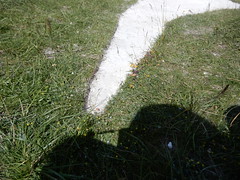So, for our anniversary this year we went to Crocodiles of the World. As I recall it all started in the back garden of an Oxfordshire-based crocodile enthusiast. Now it's a creditable and rather enjoyable mini-zoo, with some interesting breeding programmes (Tomistoma, your favourite crocodilian you have never heard of; some spectacular Giant Tortoises) and a pleasant aesthetic, partway between traditional reptile hot-house and modern zoo. Here's some views of the cages, all attractively tormented wooden lounging spaces and pot plants gone semi-wild. That's a Green Tree Monitor, I think.
Outside, for the Tortoises great and small, open grazing paddocks punctuated with constructed boulders and miniature palms alternate with warm-houses planted up with every house plant that ever wished their home was bigger, brighter and warmer.
But this is actually what we're here for. The Crocodiles:
Outside, for the Tortoises great and small, open grazing paddocks punctuated with constructed boulders and miniature palms alternate with warm-houses planted up with every house plant that ever wished their home was bigger, brighter and warmer.
Like many a small zoo, it has gathered some off-topic items. Meercats, squabbling Otters, an invisible Fishing Cat, a sword-beaked Kookaburra. The aesthetic for these pens is firmly modern zoo, with human observation posts and animal display perches:
But this is actually what we're here for. The Crocodiles:
As an aspiring supervillain, the idea of having dangerous animals in my garden appeals mightily. I pick out Black Caiman as the most handsome of the Crocs and therefore the bext choice for my fantasy back garden crocodile pit (though the most dangerous are probably their small congregation of colossal Alligators, kept on their own in a very safe sunken pen with a sheltered observation platform) but Nile Crocodiles are the classic sociable croc, an easier breeder and more widely available and probably the most practical choice for your garden crocodile pit. Here's their colossal float of Nile Crocs being given an "enrichment feed" for the entertainment of both the animals and the visitors. Large feeds are more intermittent, and medium feeds are introduced periodically for crocs that seem to be eating less. That sounds like a regime that could gel with supervillain life quite tidily.
As you can see, this is an indoor pit. It's too cold outside for most reptiles in this country. So your fantasy back-garden crocodile pit does need a roof, secure walls, a feeding platform and some cheerful greenery. And once you have a Crocodile House, you also have a Tropical House, so you might as well have some insects and birds flying free in it to engage the exotic plants and humbly approach biome.

















































